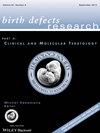Surveillance of ventricular septal defects in Delaware.
Q Medicine
Birth defects research. Part A, Clinical and molecular teratology
Pub Date : 2016-11-01
DOI:10.1002/bdra.23574
引用次数: 3
Abstract
BACKGROUND The prevalence of ventricular septal defects (VSDs), a birth defect in which there is an opening in the wall that separates the left and right ventricles of the heart, seemed to be substantially higher in Delaware compared with the National Birth Defects Prevention Network (NBDPN). The Delaware Birth Defects Registry (BDR) noted their high prevalence of VSDs in comparison with other states. METHODS A subset of children with a VSD born in 2007 through 2010 was identified from the complete reportable statewide defect list that the BDR creates each year. VSDs were categorized by type of VSD (muscular, perimembranous, conotruncal, or atrioventricular septal defect), by either isolated or complex, and then by spontaneously closed, surgically closed, open but clinically insignificant, lost to follow-up, fetal or neonatal death. RESULTS The BDR team found a prevalence of VSD of 83.4 per 10,000 including fetal/neonatal deaths. Excluding fetal and neonatal deaths the prevalence was 78.7 per 10,000 live births. Excluding small muscular VSDs, the prevalence in Delaware falls to 25.7 per 10,000. CONCLUSION The BDR team chose to include all babies with all types of VSDs. Using these criteria Delaware's prevalence of 78.7 was higher than that reported by other states (whose prevalence ranges from 1.6 to 70.0 per 10,000 live births) (National Birth Defects Prevention Network, ). Delaware's prevalence is similar to other states when small muscular VSDs are excluded. Birth Defects Research (Part A) 106:888-893, 2016. © 2016 Wiley Periodicals, Inc.特拉华州室间隔缺损的监测。
背景:与全国出生缺陷预防网络(NBDPN)相比,特拉华州室间隔缺损(VSDs)的患病率似乎要高得多,室间隔缺损是一种出生缺陷,即在心室壁上有一个开口,将左心室和右心室分开。特拉华州出生缺陷登记处(BDR)指出,与其他州相比,他们的VSDs患病率较高。方法从BDR每年创建的完整的可报告的全州缺陷列表中确定2007年至2010年出生的VSD儿童子集。根据室间隔缺损的类型(肌肉型、膜周型、椎体状或房室间隔缺损)、单纯性或复合性室间隔缺损、自发闭合性、手术闭合性、开放性但临床不明显、随访失败、胎儿或新生儿死亡进行分类。结果BDR团队发现VSD患病率为83.4 / 10000,包括胎儿/新生儿死亡。不包括胎儿和新生儿死亡,患病率为每10 000例活产78.7例。不包括小型肌肉性室性血管病,特拉华州的患病率降至25.7 / 10000。结论BDR团队选择包括所有类型室间隔的婴儿。使用这些标准,特拉华州的患病率为78.7,高于其他州的报告(其患病率范围为每10,000例活产1.6至70.0)(国家出生缺陷预防网络,)。特拉华州的患病率与其他州相似,但不包括小型肌肉性室性血管病。出生缺陷研究(A辑)(6):888-893,2016。©2016 Wiley期刊公司
本文章由计算机程序翻译,如有差异,请以英文原文为准。
求助全文
约1分钟内获得全文
求助全文
来源期刊

Birth defects research. Part A, Clinical and molecular teratology
医药科学, 胎儿发育与产前诊断, 生殖系统/围生医学/新生儿
CiteScore
1.86
自引率
0.00%
发文量
0
审稿时长
3 months
 求助内容:
求助内容: 应助结果提醒方式:
应助结果提醒方式:


